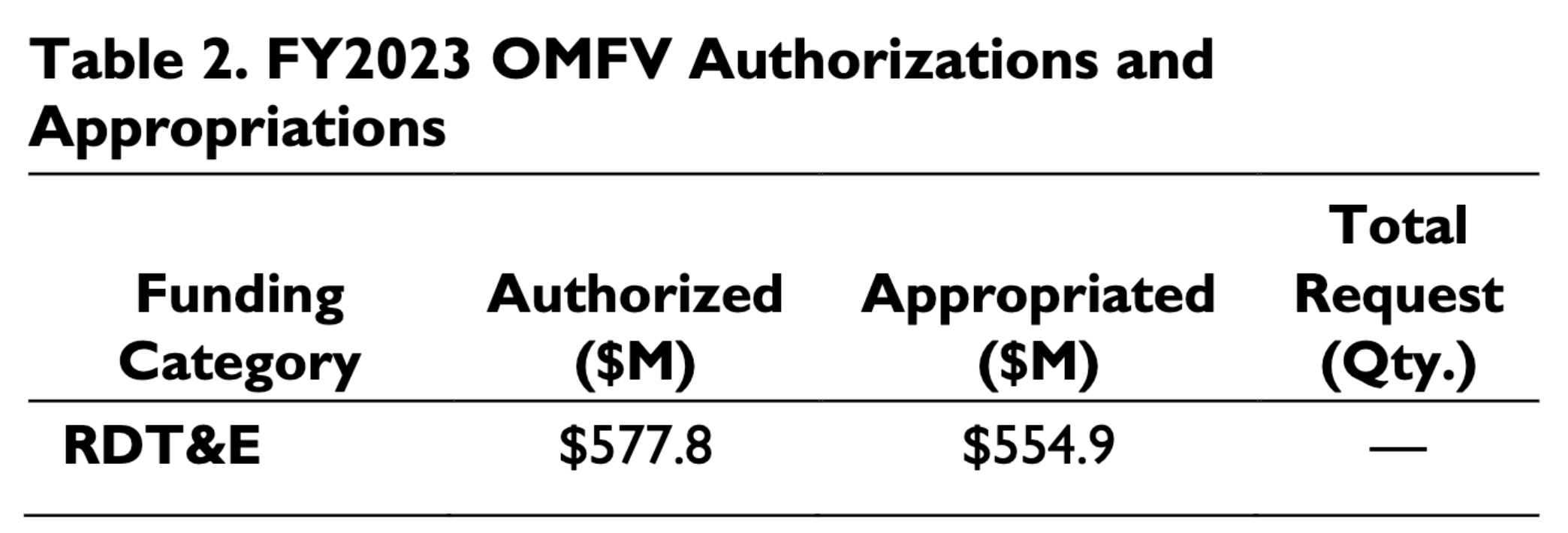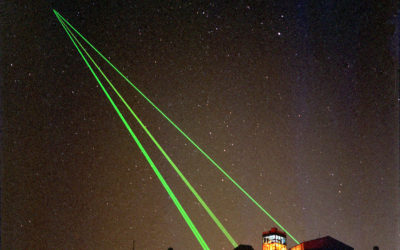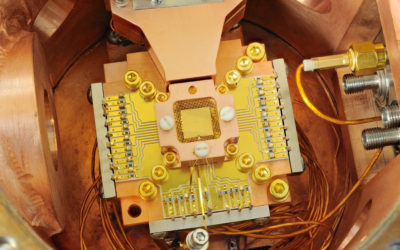“God mode”, for those who aren’t gamers, is a mode of operation (or cheat) built into some types of games based around shooting things. In God mode you are invulnerable to damage and you never run out of ammunition.
The Army’s Optionally Manned Fighting Vehicle (OMFV)
The Army’s Optionally Manned Fighting Vehicle (OMFV)
The Army’s Optionally Manned Fighting Vehicle (OMFV)
The Army’s Optionally Manned Fighting Vehicle (OMFV) is being designed to replace the M-2 Bradley Infantry Fighting Vehicle (IFV) (see cover photo for a notional example). Optionally manned means the OMFV is to have the ability to conduct remotely controlled operations while a crew is not in the vehicle. The M-2 Bradley, which has been in service since 1981, transports infantry on the battlefield, provides fire support to dismounted troops, and can destroy enemy fighting vehicles. Updated numerous times since its introduction, the M-2 Bradley is widely considered to have reached the technological limits of its capacity to accommodate new electronics, armor, and defensive systems. Two past efforts to replace the M-2 Bradley—the Future Combat System (FCS) Program and the Ground Combat Vehicle (GCV) Program—were cancelled for programmatic and cost-associated reasons.
Role of the OMFV
According to OMFV Program Information released by theArmy on February 28, 2022:
The Optionally Manned Fighting Vehicle (OMFV) will serve as the Army’s Infantry Fighting Vehicle (IFV) tasked to maneuver through the enemy’s security zone as part of a combined arms team for the purpose of creating an advantageous position, relative to the enemy, and providing protection and direct fire lethality while manned or remotely operated. In the close fight, the OMFV enables the ability of dismounted elements to maneuver by detecting and destroying targets at a range beyond the enemy’s capability.
OMFV Capabilities
The Army notes four planned OMFV capabilities:
- Enable command and control at the platoon level andhigher by rapidly generating, receiving, and passing information to dismounted elements, other vehicles, and command nodes.
- Detect, engage, and destroy enemy infantry fighting vehicles beyond the range of the enemy’s primary weapon system, and rapidly defeat dismounted enemy infantry threats. The OMFV would also enhance unit-level lethality by providing target acquisition data, shared situational understanding, and the lethal effects required to protect and orient friendly dismounted infantry.
- Improve organizational effectiveness by reducing the logistics burden on the Armored Brigade Combat Team (ABCT) through enhanced reliability and on-board diagnostics and prognostics; ease of maintenance; and reduced burdens on the supply chain in terms of spare parts, fuel, and munitions.
- Allow rapid adaptation by the means of growth margins that allow for the insertion and integration of future technologies.
OMFV Acquisition Approach
OMFV is to be Army’s first ground combat vehicle designed using state-of-the-art digital engineering tools and techniques. It is to be designed from the onset as a Modular Open Systems Architected (MOSA) platform based on an Army-defined and -owned open standard. As technology and software evolve, MOSA could potentially facilitate rapid OMFV modernization at a reduced cost. The open architecture of the OMFV could also offer more opportunities for industry competition and innovations as the OMFV is upgraded.
The Army is conducting a five-phase acquisition approach to design, prototype, test, and produce the OMFV:
- Phase 1 consists of Market Research and Requirement Development.
- Phase 2, the Concept Design Phase, includes modeling, simulation, and analysis (MS&A) to inform requirements and support initial design activities.
- Phase 3, the Detailed Design Phase, includes detailed design activities to mature OMFV designs and concludes with a Critical Design Review (CDR). A CDR is a technical review to ensure the initial product baseline is established. Successful completion of CDR provides the technical basis for proceeding into fabrication, integration, development, test, and evaluation of a system.
- Phase 4, the Prototype Build and Test Phase, verifies prototype performance against performance specifications. Late in this phase, a Limited User Test (LUT) is to be conducted.
- Phase 5, the Production and Fielding Phase, is to result in a single Low-Rate Initial Production (LRIP) contract for production, testing, and initial fielding.
Program Activities
Phase Two Contracts Awarded
The Army announced the award of five firm-fixed price contracts for OMFV Phase 2 Concept Design Phase using full and open competitive procedures on July 23, 2021. The contracts were awarded to Point Blank Enterprises, Inc. (Miami Lakes, FL); Oshkosh Defense, LLC (Oshkosh, WI); BAE Systems Land and Armaments L.P. (Sterling Heights, MI); General Dynamics Land Systems, Inc. (Sterling Heights, MI); and American Rheinmetall Vehicles, LLC (Sterling Heights, MI). The total award value for all five contracts was approximately $299.4 million. During this phase, competing firms were asked to develop digital designs. On November 1, 2022, it was reported that all five firms had submitted their OMFV digital designs prior to the November 1 deadline. All five proposals reportedly were hybrid electric vehicles. It is not known if other companies submitted OMFV digital designs by the November 1 deadline.
Planned Future Acquisition Phases
Upon successful completion of the Concept Design Phase, the Army intends to have another full and open competition for Phase 3, the Detailed Design Phase, and plans to call for an award of up to three contracts in the second quarter of FY2023. The awardees are then to transition into Phase 4, the Prototype Build and Test Phase, in order to build and test actual prototypes. The Army then intends to select one vendor for Low-Rate Initial Production near the end of FY2027.
FY2023 OMFV Budgetary Information

Source: Department of Defense Fiscal Year (FY) 2023 Budget Estimates, Army Justification Book Volume 2e of 2 Research, Development, Test & Evaluation, Army RDT&E − Volume II, Budget Activity 5D, April, 2022, p. 259. Notes: RDT&E = Research, Development, Test & Evaluation: $M = U.S. dollars in millions; Qty. = FY2023 procurement quantities.

Sources: Authorized: Rules Committee Print 117–70 Text of the House Amendment to the Senate Amendment to H.R. 7776 [Showing the text of the James M. Inhofe National Defense Authorization Act for Fiscal Year 2023], December 6, 2022, p. 1810. Appropriated: Fiscal Year 2023 Omnibus Appropriations Bill, H.R. 2617, Division C – Department of Defense Appropriations Act, 2023, December 19, 2022, p. 89N.
Potential Issues for U.S. Congress
The Army’s Plans for OMFV Fielding
- The Army has, at present, 11 Active ABCTs and 5 Army National Guard ABCTs. There are around 150 M-2 Bradleys in each ABCT, for a total of 2,400 M-2s dedicated to ABCTs.
- Will OMFVs replace M-2s in ABCTS on a one-for-one basis? If not, how many OMFVs are planned for each ABCT?
- How many additional OMFVs will be required over and above those needed for ABCTs? How many OMFVs will be required for Army Prepositioned Stocks?
- In the past, the Army has fielded new systems as a brigade set. Does the Army intend to field OMFVs as a brigade set? If so, how many ABCTs per year are planned to be equipped with OMFVs?
Lessons Learned from the Ukraine Conflict
There are a number of military observations emerging from the current Ukraine conflict. One observation is that Russian armored vehicles have allegedly proven highly vulnerable to anti-tank guided missiles (ATGMs) such as the Javelin ATGM. Reports suggest the Russians have lost significant numbers of armored vehicles to ATGM systems. Given this observation and its possible implications for armored fighting vehicles in general, what are some of the lessons learned about armored fighting vehicle vulnerability to ATGMs? Does the Army have plans to incorporate Ukraine lessons learned into OMFV design? If so, what are some of the potential design changes/new capabilities planned for incorporation into final OMFV design? Are there cost implications associated with potential OMFV design changes/new capabilities?
Republished in the State of California as a work of the United States government.

Andrew Feickert is a specialist in military ground forces.
Related Articles
Understanding the building blocks for Australia’s quantum future
Australia is undergoing an exciting period of strategic technology policy review and development. The release of its first National Quantum Strategy this week committed the government to building the world’s first error-corrected quantum computer. This is a strategically important technology that has the potential to improve productivity and supply chain efficiency in diverse industries, lower costs across the economy, help reduce carbon emissions and improve public transportation.
Japan needs stronger deterrence than its new defense strategy signals
Since World War II, Japan had long chosen not to possess long-range strike capabilities that could be used against enemy bases. But the Japanese government changed course in December 2022 when it adopted the new national defense strategy (NDS), which included a commitment to acquiring a so-called counterstrike capability. But in order for this new strategy to contribute to deterrence and alter the nation’s defensive role as the ‘shield’ in its alliance with the United States, Tokyo needs to go further than what the NDS outlines.



